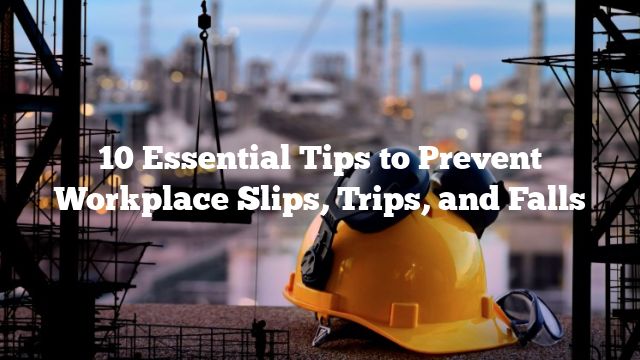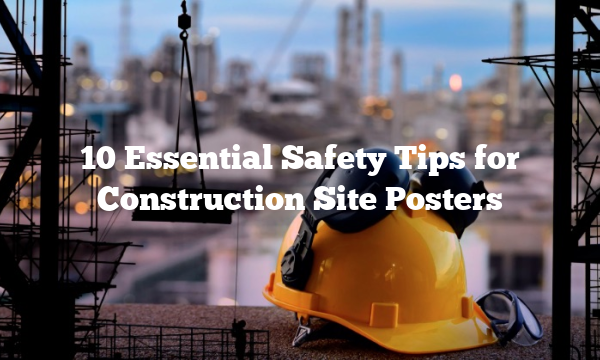Introduction:
Slips, trips, and falls are common hazards in the workplace that can lead to serious injuries or even fatalities. Whether it’s a slippery floor, cluttered walkways, or poor lighting, these accidents can happen to anyone, anywhere, at any time. As an employer or employee, it is essential to take proactive steps to prevent such incidents from happening. In this article, we will discuss workplace slips, trips, and falls prevention. We will provide you with tips, tutorials, and listicles that can help you avoid these hazards and ensure a safe working environment.
What is Workplace Slips Trips and Falls Prevention?
Workplace slips, trips, and falls prevention are the measures taken to reduce the risk of accidents caused by slippery or uneven surfaces, cluttered walkways, poor lighting, or any other hazard that can cause a person to lose balance and fall. It involves identifying potential hazards, implementing preventive measures, and educating employees on how to avoid such hazards.
Facts about Workplace Slips Trips and Falls Prevention:
1. Slips, trips, and falls are the most common cause of workplace injuries, accounting for 25% of all reported injuries.
2. They are also the second leading cause of workplace fatalities, with over 800 deaths each year.
3. The cost of workplace slips, trips, and falls is estimated to be around $11 billion annually in the US alone.
4. Most of these accidents happen in the healthcare, retail, and hospitality industries.
Tutorial of Workplace Slips Trips and Falls Prevention:
Identifying potential hazards is the first step in preventing slips, trips, and falls in the workplace. Here are some tutorials that can help you identify and address these hazards:
1. Keep floors clean and dry
Clean up spills immediately and mark wet areas with warning signs. Use slip-resistant mats in areas that are prone to spills.
2. Reduce clutter
Keep walkways and stairs free of clutter and obstacles. Ensure that all equipment and supplies are stored properly.
3. Improve lighting
Ensure that all areas are well-lit, especially stairways, walkways, and storage areas. Use extra lighting in dimly-lit areas.
4. Install handrails and guardrails
Install handrails on stairs and guardrails on elevated walkways to provide support and prevent falls.
5. Provide proper footwear
Provide slip-resistant footwear to employees who work in areas that are prone to slips and falls.
Tips of Workplace Slips Trips and Falls Prevention:
Here are some additional tips that can help prevent slips, trips, and falls in the workplace:
1. Encourage employees to report hazards
Create an environment where employees feel comfortable reporting hazards or potential hazards. Provide them with a way to report these hazards anonymously if necessary.
2. Conduct regular safety inspections
Regularly inspect the workplace for potential hazards and address them immediately.
3. Provide safety training
Provide employees with regular safety training that covers topics such as hazard identification, proper footwear, and safe lifting techniques.
4. Use safety signs and labels
Use safety signs and labels to warn employees of potential hazards, such as wet floors or uneven surfaces.
Question and Answer of Workplace Slips Trips and Falls Prevention:
1. What are the most common causes of workplace slips, trips, and falls?
The most common causes of slips, trips, and falls in the workplace are wet or slippery floors, cluttered walkways, poor lighting, and uneven surfaces.
2. How can employers prevent slips, trips, and falls in the workplace?
Employers can prevent slips, trips, and falls in the workplace by identifying potential hazards, implementing preventive measures, and providing employees with safety training and proper equipment.
3. What should employees do if they notice a potential hazard in the workplace?
Employees should report potential hazards to their supervisor or manager immediately. If they are uncomfortable reporting the hazard to their supervisor, they can report it anonymously.
4. How can employees protect themselves from slips, trips, and falls in the workplace?
Employees can protect themselves from slips, trips, and falls in the workplace by wearing slip-resistant footwear, being aware of their surroundings, and reporting potential hazards to their supervisor.
Conclusion of Workplace Slips Trips and Falls Prevention:
Workplace slips, trips, and falls prevention are crucial for maintaining a safe and healthy working environment. By identifying potential hazards, implementing preventive measures, and providing employees with safety training, employers can significantly reduce the risk of such accidents. Likewise, employees can protect themselves by being aware of their surroundings, reporting hazards, and wearing proper footwear. Remember, a safe workplace is everyone’s responsibility.
Recommendations:
- 7 Tips for Preventing Slips, Trips, and Falls in the… Introduction: Slips, trips, and falls are some of the most common workplace accidents, causing not only physical harm but also financial losses for businesses. According to the Occupational Safety and…
- 10 Essential Safety Precautions to Protect Your Home Introduction: Safety precautions are essential in every aspect of our lives, whether we are at home, work, or outdoors. The importance of safety precautions cannot be overemphasized, as they help…
- Safety Topics Slips Trips And Falls Slips trips and falls is the number 1 reason for an industrial injury in the united states. Preventing slips trips falls safety talk meeting outline follow up on any outstanding…
- Health & Safety Pictures If you're searching for health & safety pictures pictures information connected with to the health & safety pictures topic, you have pay a visit to the ideal site. Our site…
- 10 Tips for Preventing Slips, Trips and Falls in the… Workplace Slips Trips and Falls Prevention: Essential Tips and Facts Accidents in the workplace can happen anytime, anywhere. One of the most common types of these accidents is slips, trips,…
- Health And Safety Funny Images If you're searching for health and safety funny images images information related to the health and safety funny images interest, you have pay a visit to the right site. Our…
- Safe And Healthy Images If you're looking for safe and healthy images images information connected with to the safe and healthy images keyword, you have visit the right blog. Our site frequently provides you…
- The Importance of Safety Precautions in the Workplace \ Introduction: Safety is of utmost importance in any workplace or environment, whether it is at home or at work. Every year, thousands of accidents happen, and people get injured…
- The Top 10 Safety Hazard In Kitchen and How To… Each group is allocated one of the food safety hazard in kitchen and must come up with a short drama that shows. We use our kitchens every day to prepare…
- Safety Quotes Images A safety leader will go above and beyond to make safety a priorityfor themselves and for those around them. Safety images photos unsafe pictures and funny fails. Safety Doesn T…
- 7 Tips for Preventing Workplace Slips, Trips, and Falls Workplace Slips Trips and Falls Prevention As an employee or an employer, have you ever thought about the importance of preventing slips, trips, and falls in the workplace? Workplace slips,…
- Take 5 Safety Poster Large colorful and motivational banners and posters promote safety job quality accident prevention teamwork and much more. Safety briefs a set of 12 11x145 posters that take advantage of the…
- Inside a Comprehensive Health and Safety Inspection… \\\". Introduction: Health and safety inspection report example is a crucial document that highlights the results of a thorough inspection of a workplace or building. This report ensures that the…
- Discover Job Hazard Analysis Examples to Improve… Job Hazard Analysis Examples. Every workplace has its own set of safety standards and procedures. But it can be difficult to know which safety protocols are most effective, and which…
- The Importance of Job Safety Analysis for Loading… Job Safety Analysis for Loading and Unloading: Keeping Workers Safe As businesses continue to grow, loading and unloading activities have become more common. While these activities are necessary for the…
- 5 Tips for Preventing Workplace Slips, Trips, and Falls Workplace Slips Trips and Falls Prevention Every year, millions of people suffer from injuries caused by slips, trips, and falls in the workplace. These accidents can happen in any industry,…
- Safety First? These Work Photos Say Otherwise! Introduction: Workplace safety is a critical component of any organization. Employees are the backbone of any company, and their well-being should always be a top priority. However, there are times…
- 10 Creative Fire Prevention Poster Ideas for Your… Fire Prevention Poster Making Ideas: How to Keep Your Community Safe Fire prevention is an important aspect of keeping our communities safe. While fire emergencies can happen anywhere at any…
- 10 Essential Tips for Drawing Safely Introduction: Drawing is an art form that requires skill, patience, and creativity. However, safety is also an essential aspect of drawing that should not be overlooked. Drawing can be hazardous…
- Health And Safety Inspection Report Template Use for office health and safety audits. Add a badge to your website or intranet so your workers can quickly find answers to their health and safety questions. Safety Report…
- Why An Electrical Safety Code Poster Is Essential… Introduction Electricity and fire are two of the most dangerous elements that can cause harm to individuals and property. Electrical and fire safety code posters are essential to ensure safety…
- The Top 10 Kitchen Hazards You Need to Know About Introduction The kitchen is the heart of any home, and it is where most of the household activities take place. However, it is also one of the most dangerous places…
- The Importance of Industrial Safety Drawing in… Industrial Safety Drawing: Ensuring Safe Work Environments 👷♂️👷♀️Safety is an essential aspect of any industrial workplace. However, the use of heavy machinery, electrical equipment, and hazardous materials can lead to…
- 10 Tips for Safe Ladder Use Introduction Workplace safety is of critical importance, and employers are required to take all necessary measures to ensure the safety of their employees. One of the most effective ways to…
- 10 Tips to Prevent Workplace Slips, Trips, and Falls Introduction: Slips, trips, and falls are among the most common workplace accidents. They can happen anywhere, anytime, and to anyone. These accidents can cause serious injuries, and in some cases,…
- 10 Tips for Preventing Slips, Trips, and Falls in… Introduction: No one wants to see their colleagues or employees get hurt on the job. However, workplace slips, trips, and falls are a common cause of injuries in many industries.…
- Safety Committee Images If you're searching for safety committee images images information linked to the safety committee images topic, you have visit the right site. Our site frequently provides you with suggestions for…
- Understanding Safety Precautions: Definition and Importance Introduction Safety precautions are steps taken to reduce the risk of harm to individuals or organizations. Safety precautions are an essential part of everyday life, and they are particularly important…
- 7 Essential Tips for Preventing Workplace Slips,… Workplace Slips Trips and Falls Prevention Did you know that slips, trips, and falls are one of the leading causes of workplace accidents? According to the US Bureau of Labor…
- Occupational Health And Safety Logo Information and documents a z. Occupational health and safety png images. Occupational Health Safety Logo Free Transparent Png Download Health and safety sign board hair. Occupational health and safety logo.…
Advertisement
Scroll to Continue With Content




